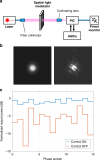Integrated electronic controller for dynamic self-configuration of photonic circuits
- PMID: 41022703
- PMCID: PMC12480261
- DOI: 10.1038/s41377-025-01977-w
Integrated electronic controller for dynamic self-configuration of photonic circuits
Abstract
Reconfigurable photonic integrated circuits (PICs) can implement arbitrary operations and signal processing functionalities directly in the optical domain. Run-time configuration of these circuits requires an electronic control layer to adjust the working point of their building elements and compensate for thermal drifts or degradations of the input signal. As the advancement of photonic foundries enables the fabrication of chips of increasing complexity, developing scalable electronic controllers becomes crucial for the operation of complex PICs. In this paper, we present an electronic application-specific integrated circuit (ASIC) designed for reconfiguration of PICs featuring numerous tunable elements. Each channel of the ASIC controller independently addresses one optical component of the PIC, and multiple parallel local feedback loops are operated to achieve full control. The proposed design is validated through real-time reconfiguration of a 16-channel silicon photonics adaptive universal beam coupler. Results demonstrate automatic coupling of an arbitrary input beam to a single-mode waveguide, dynamic compensation of beam wavefront distortions and successful transmission of a 50 Gbit/s signal through an optical free-space link. The low power consumption and compactness of the electronic chip provide a scalable paradigm that can be seamlessly extended to larger photonic architectures.
© 2025. The Author(s).
Conflict of interest statement
Conflict of interest: The authors declare no competing interests.
Figures






References
-
- Bogaerts, W. et al. Programmable photonic circuits. Nature586, 207–216 (2020). - PubMed
-
- Catalá-Lahoz, C., Pérez-López, D., Huy-Ho, T. & Capmany, J. Self-configuring programmable silicon photonic filter for integrated microwave photonic processors. APL Photonics8, 116103 (2023).
-
- Burla, M. et al. On-chip CMOS compatible reconfigurable optical delay line with separate carrier tuning for microwave photonic signal processing. Opt. Express19, 21475–21484 (2011). - PubMed
-
- Kari, S. R., Nobile, N. A., Pantin, D., Shah, V. & Youngblood, N. Realization of an integrated coherent photonic platform for scalable matrix operations. Optica11, 542–551 (2024).
LinkOut - more resources
Full Text Sources
Research Materials

